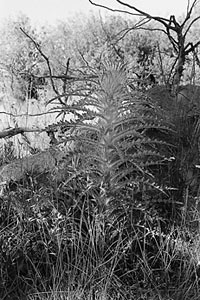
Born in 1934 in Aberdeen, Washington (US)
Lives and works in New York City, New York (US)

1977
Black and white photograph, gelatin-silver print
28,5 x 19 cm
Year of Purchase: 1991
Lee Friedlander, an admirer of Eugène Atget, is part of the tradition of photographers of American cityscapes, such as Walker Evans and Robert Frank. He puts his subjects into thematic groups: street, portrait, self-portrait, landscape, nude. His photos bear the mark of the instantaneousness, the immediacy of the shot, but without making concessions to a facile and sentimental reproduction of beings and things. Contrary to a direct confrontation, he strives toward a manner of presentation in book form – ‘Books are the best way of looking at photography’ (Lee Friedlander) which enables him to intervene with regard to the sense of reading, and create a narrative and an interaction between images, while leaving free rein to the viewer’s contemplation.
His photographs involve neither reportage nor an aestheticization of reality; they present their subject in its totality, without isolating it from its context. But, devoid of perspective, the differing planes dovetail, and bring out the details like referent-less elements. Friedlander dwells on rhythms, the explosion and chaos of intermingled lines, breaking up the image the way a collage can, up to saturation point of the space (Sonora Desert and Flowers and Trees series).
His portraits of famous people and historical monuments are not tributes to glory, and offer a new image of the United States without ideological or symbolic pretensions. The models photographed in a neutral way, emotionless, take on an anonymous and banal aspect, there is no search for any aesthetic effect. For this reason, Friedlander says he has the same way of looking at things as Flaubert, transposed to photographic praxis.
Anne Langlois